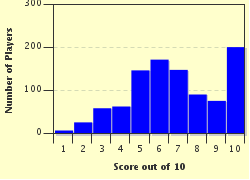Quiz Answer Key and Fun Facts
1. An unstable nucleus in an atom causes it to be radioactive. There are naturally occurring elements in the world that are inherently radioactive. Which of the following has this property?
2. The units used to describe radiation can be confusing because various terms refer to the different aspects of the relationship between radioactivity and humans. Which of the following units of measure indicates effective dose?
3. Humans regularly receive natural background radiation from several sources that are not a result of human activity. Which of the following sources accounts for the largest percentage of natural background radiation humans receive?
4. Bananas, sunflower seeds, kidney beans and potatoes are all foods that contain radioactive isotopes, but the levels of radiation are so low as to pose no danger to humans. What substance in these foods causes them to be radioactive?
5. Humans are also exposed to radiation from man-made sources. Which of the following man-made sources accounts for the largest percentage of exposure to general populations?
6. Radiation is used in medicine in the form of x-rays. Iodine 131, a man-made radioactive element, is also used in the medical field. Which of the following medical conditions is iodine 131 used to treat?
7. Workers such as nuclear power plant workers, lab technicians using radionuclides and others working in the field of nuclear medicine are potentially exposed to more radiation than the average person. Consequently, they are required to wear a device that will detect, measure and record the amount of radiation they receive. What is this type of device called?
8. The atomic bombings of Nagasaki and Hiroshima in 1945 exposed hundreds of thousands of people to ionizing radiation. Studies conducted on survivors of these bombings show an increased incidence of solid cancers, a reduction in life span as well as an increase in which of the following diseases?
9. Nuclear accidents often cause fear and concern for people all around the world regardless of where they occur. Which of the following site/sites that experienced a nuclear accident was rated serious enough for a rating of 7 by the International Atomic Energy Agency?
10. Despite the risks and dangers, many in the world believe that nuclear energy is necessary for us to meet the demands for power that our growing population faces. Which of the following countries relies on nuclear power as an energy source the most?
Source: Author
SP44000
This quiz was reviewed by FunTrivia editor
gtho4 before going online.
Any errors found in FunTrivia content are routinely corrected through our feedback system.

